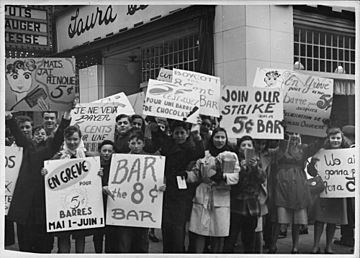Candy bar protest facts for kids
The candy bar protest was a short but exciting event in 1947. It was also called the 5 cent chocolate war or the chocolate candy bar strike. This protest happened when children across Canada got upset because the price of their favorite chocolate bars suddenly went up. They used to cost five cents, but then they jumped to eight cents! Kids decided to take action and show how they felt about this big change.
Contents
What Caused the Protest?
In 1947, right after World War II, many things were changing. The cost of making chocolate bars went up. Because of this, chocolate companies decided to raise the price of a standard chocolate bar. It went from five cents to eight cents. This might not sound like a lot, but back then, five cents was a common price for many treats. For kids, a three-cent increase was a big deal. It meant they could buy fewer candies with their pocket money.
The Five-Cent Tradition
For a long time, chocolate bars had cost just five cents. This price was easy for kids to remember. It was also easy to pay with a single nickel coin. When the price changed, it broke a long-standing tradition. Kids felt it was unfair and that their favorite treat was now too expensive.
How the Protest Started and Grew
The protest began in a small town called Ladysmith, British Columbia. Kids there decided they wouldn't buy chocolate bars at the new, higher price. They wanted the old price back. News of their protest quickly spread.
Spreading Across Canada
Soon, children in other cities heard about the Ladysmith protest. They decided to join in! The protest spread like wildfire across Canada. Kids in big cities like Calgary, Edmonton, Winnipeg, Montreal, Quebec City, Ottawa, and Toronto held their own demonstrations. Even children in the Maritimes joined the movement.
Kids Take Action
Children organized marches and pickets. They stood outside candy stores with signs. Their signs often said things like "We want our 5-cent chocolate bars!" or "Don't be a sucker, don't pay 8 cents!" They showed how strong their feelings were about the price change. Many adults and even some newspapers supported the children's cause.
How the Protest Ended
The candy bar protest was very popular for a short time. However, it didn't last forever. The protest ended when a newspaper in Toronto, called the Toronto Evening Telegram, published an article.
The End of the Strike
The newspaper article suggested that an adult group helping the children, called the National Federation of Labour Youth, had controversial political connections. This made some people nervous. The suggestion caused the protest to lose support. Without strong backing, the children's "chocolate war" slowly faded away. The price of chocolate bars stayed at eight cents.


